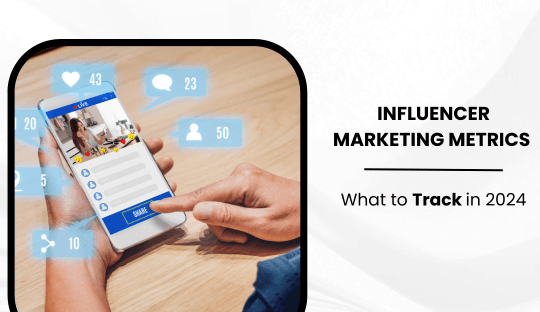
Influencer Marketing Metrics: What to Track in 2024
Influencer marketing continues to be a powerful strategy for brands, offering the potential for high engagement and authentic connections with audiences. For creative brand companies like Flykez CO in Greece, understanding and tracking the right metrics is crucial to maximizing the effectiveness of influencer campaigns. In this blog post, we’ll explore the key influencer marketing metrics to track in 2024 to ensure your campaigns deliver the best possible return on investment (ROI).
Focus Keywords: Nano-Influencers, Influencer ROI, Employee Influencers, Influencer Marketing Tools, Social Media Influencers, Influencer Content Creation, Influencer Marketing Strategy
1. Engagement Rate
Engagement rate is a vital metric for measuring how actively an influencer’s audience interacts with their content. This includes likes, comments, shares, and saves.
Why It Matters:
- Audience Interaction: High engagement indicates that the influencer’s audience is not only large but also interested and active.
- Content Resonance: Helps determine if the content is resonating with the target audience.
How to Track:
- Manual Calculation: Add up all interactions (likes, comments, shares) and divide by the total number of followers, then multiply by 100 to get the percentage.
- Tools: Use influencer marketing tools like Hootsuite, Sprout Social, or SocialBee for automated tracking.
Focus Keywords: Social Media Influencers, Influencer Marketing Tools
2. Reach and Impressions
Reach refers to the number of unique users who see the content, while impressions are the total number of times the content is displayed, regardless of clicks.
Why It Matters:
- Brand Awareness: High reach and impressions indicate widespread visibility.
- Campaign Scope: Helps assess the overall impact of the influencer’s content distribution.
How to Track:
- Platform Insights: Most social media platforms provide insights into reach and impressions.
- Analytics Tools: Tools like Google Analytics and Mention can track these metrics across different platforms.
Focus Keywords: Influencer Marketing Tools, Influencer Content Creation
3. Click-Through Rate (CTR)
CTR measures the percentage of people who click on a link in the influencer’s content. It’s a key metric for assessing the effectiveness of call-to-actions (CTAs).
Why It Matters:
- Traffic Generation: Indicates how well the content drives traffic to your website or landing page.
- Content Effectiveness: Higher CTR suggests that the audience finds the content compelling and relevant.
How to Track:
- UTM Parameters: Use UTM parameters to track clicks through Google Analytics.
- Campaign Reports: Most social media platforms provide CTR metrics in their advertising reports.
Focus Keywords: Influencer Marketing Tools, Influencer Marketing Strategy
4. Conversion Rate
Conversion rate measures the percentage of users who take a desired action after clicking on the influencer’s content, such as making a purchase or signing up for a newsletter. Also Read About Innovative Ways to Combat Influencer Fatigue in 2024
Why It Matters:
- ROI Measurement: Directly tied to sales and revenue, making it crucial for calculating ROI.
- Campaign Success: High conversion rates indicate effective influencer campaigns.
How to Track:
- E-commerce Platforms: Use e-commerce platforms like Shopify or WooCommerce to track conversions.
- Analytics Tools: Google Analytics can track conversions through goal setting.
Focus Keywords: Influencer ROI, Influencer Marketing Tools
5. Cost Per Engagement (CPE)
CPE measures the cost of each engagement (like, comment, share) and is useful for comparing the efficiency of different influencer campaigns.
Why It Matters:
- Budget Optimization: Helps in optimizing budget allocation by identifying cost-effective influencers.
- Campaign Efficiency: Lower CPE indicates more efficient spending on influencer campaigns.
How to Track:
- Campaign Analytics: Calculate CPE by dividing the total campaign cost by the number of engagements.
- Influencer Platforms: Platforms like AspireIQ and Traackr provide detailed CPE metrics.
Focus Keywords: Influencer ROI, Influencer Marketing Strategy
6. Sentiment Analysis
Sentiment analysis involves measuring the tone and emotion behind audience comments and interactions with the influencer’s content.
Why It Matters:
- Audience Perception: Helps understand how the audience feels about your brand.
- Content Impact: Positive sentiment indicates successful brand messaging.
How to Track:
- Social Listening Tools: Use tools like Brandwatch, Talkwalker, or Mention to analyze sentiment.
- Manual Review: Regularly review comments and feedback manually for sentiment cues.
Focus Keywords: Influencer Marketing Tools, Social Media Influencers
7. Influencer Content Performance
Track the performance of individual content pieces created by influencers to understand what works best.
Why It Matters:
- Content Optimization: Helps in refining content strategies based on performance data.
- Influencer Selection: Identify which influencers create the most impactful content.
How to Track:
- Engagement Metrics: Monitor likes, comments, shares, and views on each content piece.
- Content Analysis Tools: Use tools like BuzzSumo and Sprout Social for detailed content performance analysis.
Focus Keywords: Influencer Content Creation, Influencer Marketing Tools
8. Long-Term Brand Impact
Measure the long-term effects of influencer marketing on brand perception and loyalty.
Why It Matters:
- Sustained Growth: Long-term metrics help in understanding the lasting impact of influencer collaborations.
- Brand Loyalty: Assess how influencer campaigns contribute to long-term brand loyalty and customer retention.
How to Track:
- Brand Surveys: Conduct surveys to gauge brand perception before and after campaigns.
- Customer Analytics: Use CRM tools to track changes in customer loyalty and retention.
Focus Keywords: Employee Influencers, Influencer Marketing Strategy
Conclusion
Tracking the right metrics is essential for maximizing the effectiveness of your influencer marketing campaigns. By focusing on engagement rate, reach and impressions, CTR, conversion rate, CPE, sentiment analysis, content performance, and long-term brand impact, Flykez CO can ensure a successful influencer marketing strategy in 2024. These metrics provide valuable insights into the performance and ROI of your campaigns, helping you make informed decisions and optimize future efforts.
For more information on how Flykez CO can enhance your influencer marketing strategies, visit Flykez CO.
